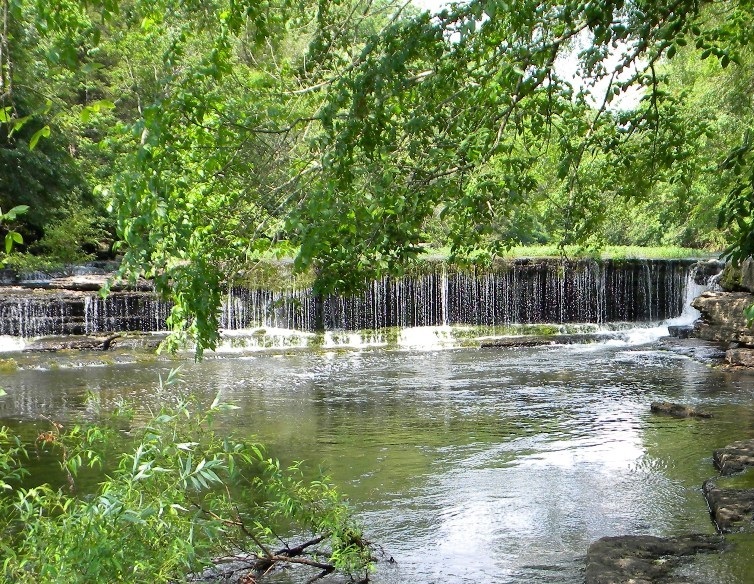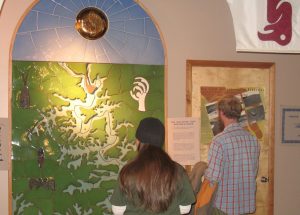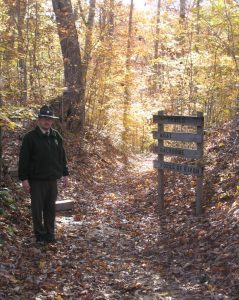This ancient, stone enclosure is one of the most interesting and beautiful places in Tennessee.
The Old Stone Fort State Archaeological Park was a gathering place for Native Americans a long time ago. When Tennessee’s settlers found it, they assumed it was a fort and gave it the name “Old Stone Fort.” But it isn’t a fort and never has been.
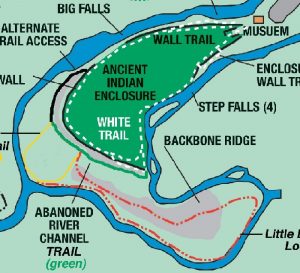 You can learn a lot at this ancient place in Coffee County. There is incredible scenery, with rivers, cliffs, and waterfalls.
You can learn a lot at this ancient place in Coffee County. There is incredible scenery, with rivers, cliffs, and waterfalls.
Let’s get started!
Old Stone Fort is located where two rivers called the Big Duck and Little Duck nearly meet, then spread apart for a while and then meet.
You can see it here on this map of the state park (the “Ancient Indian Enclosure” is the actual Old Stone Fort).
Old Stone Fort is practically surrounded on all sides by water or by cliffs.
When you get to Old Stone Fort, the first thing you’ll come to is the museum. (It is underground–cool!) Here you can learn about Old Stone Fort and the era in which it was created.
Here are some things to remember as you check out the museum: Until very recently, no one knew what Old Stone Fort was. Most of what we now know about Old Stone Fort is because of archaeological digs done here in the 1960s. That wasn’t that long ago.
Before that time there were all sorts of theories about Old Stone Fort. Some people thought it was built by de Soto. Some people thought the place was haunted!
Old Stone Fort was built during the Middle Woodland Period (about 1,500 to 2,000 years ago). This was a prehistoric era, which means people weren’t writing down what was happening yet because they didn’t have a written language.
It was during this period that Native Americans in this part of the world began using and making pottery and forming farming communities. This is the same era in which Pinson Mounds was built in what is now West Tennessee.
Native Americans used this place continuously for about 500 years. But eventually the place was abandoned.
By the time white settlers arrived, no one who lived in this area was sure why the enclosure had been built or what it had been used for. So what we know about Old Stone Fort is because of what archeologists have found here, and what they haven’t found here.
For example, no one has ever found much in the way of human remains at Old Stone Fort. So this wasn’t a burial site, nor was it a place where humans were sacrificed or anything like that. We think it was mainly used for seasonal religious ceremonies and maybe sporting events.
Before you leave the museum, ask for a free trail guide booklet.
Now it’s time for a hike. We’re going to walk along a trail that follows the wall of Old Stone Fort. Bring a camera if you have one, because there are a lot of things to take pictures of along the way.
Right off the bat you can see the walls, which have obviously settled some during the past two thousand years. The spot you see here is the entranceway. We can only imagine all the things that happened here, the processions of people who came through here into what was considered to be the sacred area.
Also, when you get to the entranceway, turn around. The people who created Old Stone Fort designed it so that this entrance faced the exact spot on the horizon where the sun rose on the Summer Solstice (the longest day of the year, which usually falls on June 20). This tells us that the people who built Old Stone Fort knew something about astronomy.
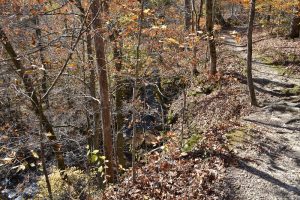 Turn left where the trail forks. Keep your eyes peeled as you head down the trail.
Turn left where the trail forks. Keep your eyes peeled as you head down the trail.
You can easily see the walls to your left, with the Little Duck River on the other side of it, and the field in the middle of Old Stone Fort to your right.
 Along the way there are many things to point out. This photograph, for instance, shows a park ranger standing next to a crooked oak tree. To his left you will notice that there is no wall here.
Along the way there are many things to point out. This photograph, for instance, shows a park ranger standing next to a crooked oak tree. To his left you will notice that there is no wall here.
What we believe happened here is that the wall collapsed and fell into the ravine because of a flood. That same flood, we think, caused this tree to grow crooked.
 As you go further down the trail you may notice rocks that look like this one. These rocks are shale. We know they came from the Little Duck River at the bottom of the cliff near here. So someone had to drag hundreds of rocks such as this one from the bottom of the cliff to the top. This rock reminds us of just how much work it was to build the walls of Old Stone Fort in the first place.
As you go further down the trail you may notice rocks that look like this one. These rocks are shale. We know they came from the Little Duck River at the bottom of the cliff near here. So someone had to drag hundreds of rocks such as this one from the bottom of the cliff to the top. This rock reminds us of just how much work it was to build the walls of Old Stone Fort in the first place.
Eventually the trail and the wall of Old Stone Fort take a sharp turn to the right, away from the water. But get this: the Big Duck River used to flow right through the valley to the left. But sometimes rivers move, which is what the Big Duck River did here. So now the valley to the left, referred to as the “moat,” is nothing more than an abandoned river bed.
Along the trail there are a couple of breaks in the wall. Here, in this photo (to the left), you can see one of them.
This break in the wall wasn’t created by the people who built Old Stone Fort. It was built in the 1800s, where a stagecoach road came right through here. You see, before highways, before railroads, this gap in Old Stone Fort was the main road from Shelbyville to Manchester.
Now we are on the Big Duck River side of Old Stone Fort. And it was on this side of the enclosure, in the late 1800s, where two small paper mills were once located. Here you can see the stone foundation of one of the paper mills (which have long since been torn down).
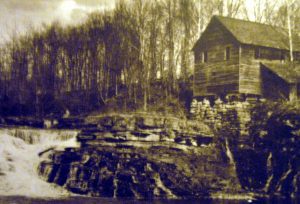 And here is an old photograph (which you can see at the Old Stone Fort Museum) of what one of the paper mills looked like.
And here is an old photograph (which you can see at the Old Stone Fort Museum) of what one of the paper mills looked like.
Much of the paper that was made here was sent to places like Nashville and Atlanta, where it was used in newspapers.
 By the way, do you see the waterfall next to the old paper mill? The paper mill may be long gone but the waterfall is still there. Here it is. Rather pretty, isn’t it?
By the way, do you see the waterfall next to the old paper mill? The paper mill may be long gone but the waterfall is still there. Here it is. Rather pretty, isn’t it?
But be careful as you walk through this area. Waterfalls and ravines are fun to look at, but they can be dangerous to explore.
Now you have returned to where the trail started. Now that you’ve learned more about Old Stone Fort, may want to go back into the museum, because you’ll probably understand more than you did the first time around.
